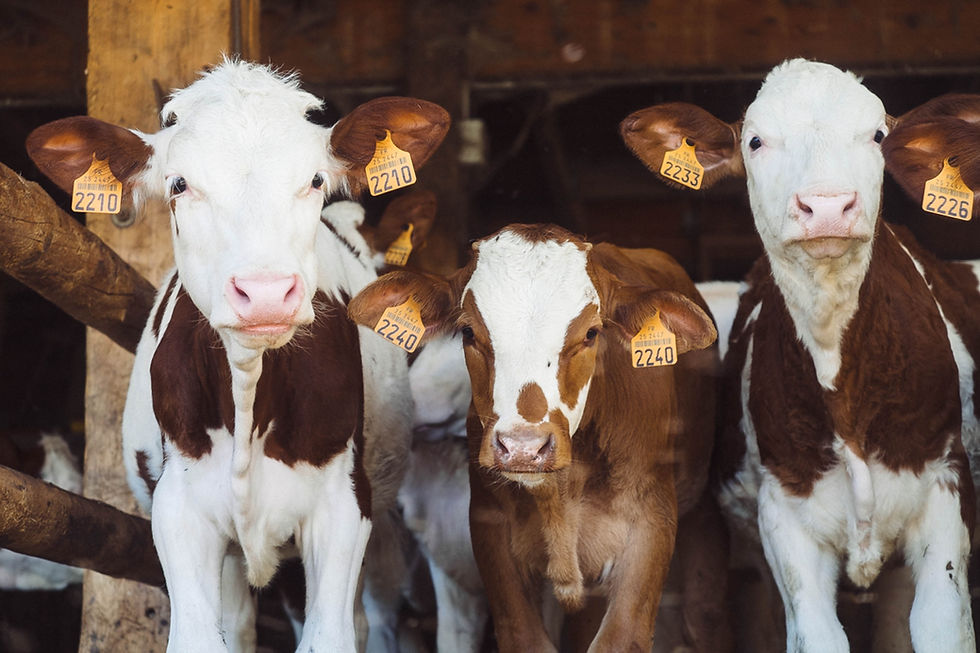
-
Milk components
-
undesirable aspects of milk
-
the future of dairy
By skipping the cow, we massively reduce greenhouse gas emissions, land and water usage and avoid animal cruelty. As well, there are no hormones or antibiotics residues in our proteins - because no animal is involved that needs to be treated with those pharmaceuticals. Our protein is biologically identical with the one from the animal and has the same high nutritional values - except that it has less allergens.
milk: a basic guide

Potential Issues with Milk
Hormones, Antibiotics & Allergens
Naturally, milk from animals contains hormones. Cow milk in particular contains the female hormone oestrogen. While this is a natural hormone and humans have been drinking cow milk for about 10'000 years, some scientists are warning that there is an increasing amount of the oestrogen hormone being found in today's cow milk.
While the impact of this increased hormone level in cows milk on the human body is unclear, it may potentially have negative effects on normal human growth rates.
antibiotics to keep cows healthy
A side effect of traditional mass dairy production is the need to use antibiotics to restore animals health when they are sick. Just like with humans, too much antiobiotic usage can create immune system issues. Sometimes is it possible that residues of cow antibiotics can be transmitted to the milk and therefore can be consumed by humans.
While regulations and quality controls are very strict on this matter, it would be preferred to have a nutrionally-equivalent dairy protein that could be produced without antibiotics.
And then also sometimes people have digestion issues with lactose, or allergies to the protein found in cow milk.
In Europe, about 5-15% of the population are lactose-intolerant. In the USA, this number rises to about 50% of the population. In China, a staggering 90% of the population are affected.
By skipping the cow, we can - of course - skip the hormones and antibiotics as well and, through our unique precision fermentation, produce a high-quality nutritionally equivalent dairy protein that is safe: hormone-free and antibiotic-free AND produced with significantly less GHG emissions.
Learn more about how we skip the cow in Our Solution.

milk and its natural components
Cow milk consists of 87,5% water, 4.8% lactose (the milk sugar), 3.8% fat, 3.4% protein and 0.5% of minerals and vitamins.
Cow milk is a major source of high-quality protein, calcium, vitamins and minerals, which are important parts of a healthy diet.
However, there are some potential issues with milk consumption, both with unwanted additives in the forms of hormones and antibiotics and allergies to lactose and milk proteins.
New alternatives
real milk, plant-based-milk and now one more thing?
What is it all about?

You probably know from the meat industry the difference between
-
Real meat from real (dead) animals - the original
-
Meat alternatives from mostly plant-based sources that taste, look and feel differently (ie quorn, soy, bean) - the alternative
-
and cultured meats that are grown and harvested in labs or - at industrial scale - in large fermentation vessels. These taste the same as "real" meat and are the next big thing
Categories of dairy proteins
In dairy, we see the same categories with the "lab grown" dairy proteins sector on the rise, just like us.
-
Real milk from real animals like cows, goats, buffalo, camels or other mammals - the original. Actually, this is the only food that is allowed to be called "milk": something that comes out of an animal through an udder.
-
Plant-based milks like oat-milk, almond-milk, soy-milk rice-milk, pea-milk and so on. The thing is, these products taste and look different than animal milk, and have very different nutritional profiles. Yes, they do also have reduced GHG emissions compared to animal milk, like us, because they do not rely on traditional animal agriculture, but unfortunately there are other high environmental land and water usage costs associated with their productions, as well as the negative ecological impacts of creating large mono-cultures of the different source crops.
-
Cultured milk - "lab-grown" dairy that is produced in a lab or fermentation vessel, just like we do. This is biologically identical and therefore nutritionally equivalent to animal-produced dairy and also tastes the same.
Let us explain how this is even possible! Read about how we create our lab-grown dairy proteins in Our Solutions.
The solution
Read more about how we developed a unique precision fermentation process to produce a powder form
of dairy proteins - without needing a cow. *MAGIC*
our research
We are a million times faster in our research process, which helps us create our dairy protein-producing microorganism. Read more about how we do it here.
The Opportunity
Read more about some of the complexities of climate change and how we are skipping the cow in the global food supply chain and greatly reducing our dependency on traditional animal agriculture and massively reducing GHG emissions - all while continuing to produce dairy proteins with high-quality nutritional value
Learn More About What We are Doing and Why
